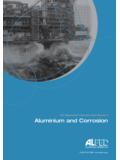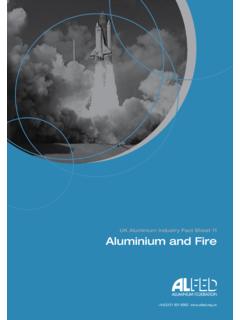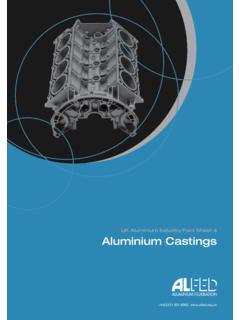Transcription of UK Aluminium Industry Fact Sheet 10 Aluminium Finishing
1 UK Aluminium Industry fact Sheet 10 : Aluminium Finishing1 Aluminium FinishingUK Aluminium Industry fact Sheet 10+44(0)121 601 6363 UK Aluminium Industry fact Sheet 10 : Aluminium Finishing1 Introduction Aluminium is a strong and durable metal with a natural ability to form a protective oxide layer when exposed to the atmosphere. The structural integrity is not impaired by atmospheric attack. Where the preservation of the metal s surface appearance is desirable, or where a colour finish is required, Aluminium can be treated with a variety of finishes including mechanical and chemical finishes, plating, anodising and organic coating. The most widely used processes are anodising and painting (organic coating).The ProcessAnodisingAnodising is an electrolytic process that produces a dense, chemically stable protective Aluminium oxide film that is an integral part of the underlying Aluminium it cannot peel or flake off.
2 Most films produced by anodising are translucent and so show the silvery look of the Aluminium but various colours are achievable by a variety of anodising process variations. The main type of anodising process used for general purposes is based on a sulphuric acid electrolyte, producing an ideal combination of decorative and protective properties. The sealing of the anodic film in boiling water after anodising is an important part of the surface coatings can be applied in a number of ways but, in all of them, it is essential that the Aluminium is pre-treated properly, normally by cleaning, etching and chemical conversion of the Aluminium surface to ensure long-term adhesion of the coating. Three important processes are described below:The most common method of paint application is powder coating, electrostatically applied and thermally cured under closely controlled conditions.
3 A wide range of colours and finishes are available, with coating systems designed for many purposes including long-term external architectural and automotive paint systems such as PVDF may also be used, but require a clear top coat as well as the colour coat. However, these may be preferred in certain coating or E-coating enables very sound, thin, uniform coatings to be achieved, but due to the size of the paint bath and the quantity of paint required it is not economic to change the paint colour continually. As a result only very limited colours are usually offered. It is normally considered an aesthetic finish or used in architectural work. The ProductAnodisingRolled, extruded, drawn, cast and forged Aluminium products can all be anodised. There are marked differences in the results however, and not all alloys are recommended for this treatment.
4 For instance, Aluminium -silicon alloys present a natural grey anodic coating whereas, by choosing a special bright trim alloy, a highly reflective mirror-like finish is attainable. Various standard thicknesses of anodic film are available which are relevant to various applications. Thicknesses can vary from 5 microns to 25 microns. The choice of grade depends upon the application. 25 microns should be specified for more demanding exterior applications whilst 10 microns and 15 microns are generally used for interior applications. For decorative trim applications a thickness of 5 microns is often used. UK Aluminium Industry fact Sheet 10 : Aluminium Finishing2 Hard anodising produces thick, abrasion resistant films. Using a low temperature electrolyte, films of up to 125 microns can be of the very diverse uses for anodised Aluminium include: electronic components; furniture; kitchen trim; lighting systems; yacht masts; windows; curtain walling; balustrading; nameplates; handles and aircraft British Standards concerned with anodising are BS 3987 (architectural anodising), BS 5599 (hard anodising), and most importantly BS EN 12373 in 19 Aluminium is specified in many industries.
5 In building it is used for exterior or interior applications. Polyester powder coatings are a minimum of 40 microns thick, compared with the thickness of 25 microns normally applied by electrophoresis. Powder coatings are available in a wide range of colours, with metallic, gloss, matt and other decorative options. There are two British Standards which relate to organic coatings on architectural Aluminium namely, BS 4842 - liquid organic coatings and BS 6496 - powder organic coatings. The Structure of the UK IndustryFinishing companies may be integrated into major Aluminium companies or they may be independent companies. The role of the applicator is vitally important in producing high quality coatings on Aluminium and members of the Aluminium Finishing Association are all dedicated to the production of a quality Further information about Aluminium and Aluminium alloys, their production, fabrication and end use can be obtained from:(1) European Aluminium Association in (2) International Aluminium Institute in London






